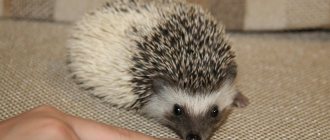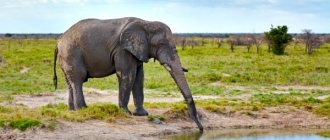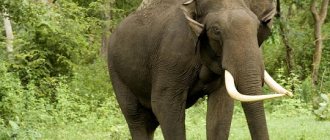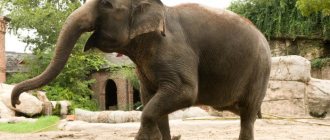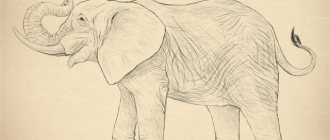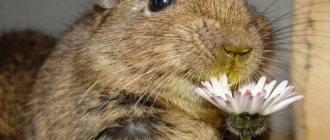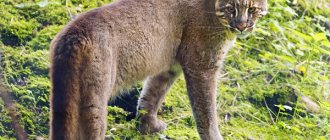Name: Borneo pygmy elephant. | How much does it weigh: 2-3 tons.
Height: 2-2.5 m. | Where he lives: northeastern part of the island of Borneo (Malaysia).
The smallest elephants in the world are those from the island of Borneo. Their scientific name is Elephas Maximus Borneensis. Bornean elephant
, or
the Borneo Dwarf Elephant
, is one of the subspecies of the Asian Elephant. The population of dwarf elephants does not live throughout Borneo, but only in Malaysia in the state of Sabah and is occasionally found in the Indonesian part of the island.
The habitat of Borneo pygmy elephants is explained by their diet. In addition to various greens in the form of herbs, palm leaves, wild bananas, bark, nuts, fruits, seeds, animals also need minerals for full development. And they find them in the form of solonetzes or mineral concentrates in limestone outcrops on the banks of the river.
The world's smallest elephant is the Borneo Pygmy Elephant. photo — David Evison/Shutterstock
Habitat
The smallest elephants on our planet live in Borneo. It is the third largest island in the world and the largest in Asia. On its territory the borders of three countries meet - Indonesia, Malaysia and Brunei. Almost the entire territory of Borneo is covered with dense equatorial forests; there are areas where no human has set foot. Perhaps there are still species of animals and plants on the island that modern biologists know nothing about.
Borneo's pygmy elephants live only on a small part of the island belonging to Malaysia, in the state of Sabah. Sometimes you can meet these amazing animals in Indonesia. The habitat of pygmy elephants is associated with their eating habits.
Dwarf elephants of Borneo feed on various greens: herbs, juicy palm leaves, wild bananas, bark, nuts, various fruits, seeds. These animals also need minerals that ensure their harmonious development. Elephants get essential minerals from salt licks and other limestone deposits that can be found on river banks.
Distribution and habitat
Elephants are found in the northern and northeastern parts of Borneo.[7] In the 1980s in Sabah, within the Tabin Nature Reserve and neighboring mostly logged dipterocarp forest on steep terrain; and in hilly terrain ranging from 300 to 1,500 m (980 to 4,920 ft) above sea level in a dipterocarp forest that was largely intact at the time and was logged only in the periphery. In Kalimantan, their range is limited to a small adjacent area of the upper Sembakung River in the east.[8]
The range of wild elephants in Sabah and Kalimantan appears to have expanded very little over the last 100 years, despite access to suitable habitat elsewhere in Borneo. Borneo's soil tends to be young, leached, and infertile, and there is speculation that the distribution of wild elephants on the island may be limited by the occurrence of natural mineral springs.[9]
In 1992, the estimated elephant population in Sabah ranged from 500–2,000 based on surveys conducted in Sabah. Tabin Nature Reserve, in the Lower Kinabatangan region and in the Deramakot Forest Reserve. An elephant census was conducted in Sabah between July 2007 and December 2008, which counted dung piles along the 216 transects in five major elephant-controlled ranges, totaling 186.12 km (115.65 mi) . The results of this study indicate that the elephant population ranges from 1,184 to 3,652 individuals inhabiting the Tabin, Lower Kinabatangan, North Kinabatangan, Ulu Kalumpang Forest Reserve and Sabah Central Forest ranges. Elephant densities and population sizes varied across five key habitats, influenced by (i) lowland forest conversion, (ii) habitat fragmentation and (iii) existing land uses such as logging. The upper catchment of the Ulu Segama Forest Reserve has the highest density of elephants, with 3.69 elephants per km2 (0.39 sq mi). More than 1,000 elephants lived in the unprotected central forest area alone.[10]
In 2005, five female elephants were fitted with tracking devices to study their home range and movement patterns in Sabah. The results indicate that elephant herds occupied a minimum area of 250 to 400 km2 (97 to 154 sq mi) in unfragmented forest, while in fragmented forest habitats, the annual range of elephants is estimated to be approximately 600 km2 (230 sq mi). miles).[11]
What size are they
The smallest elephants in the world are a subspecies of Asian elephants. The dwarf elephant, a photo of which you can see in this article, lives in the northeastern part of the island. What are the features of the appearance of these animals?
Many people are interested in how tall a dwarf elephant is. Its dimensions are not as miniature as the name of the subspecies suggests. The height of an adult pygmy elephant is 2-2.5 meters. Weight can reach 2-3 tons.
For comparison, let's look at the sizes of their closest relatives, Asian elephants, which reach 3.5 meters in height and can weigh up to 4.5 tons.
The largest African elephant in history weighed more than 12 tons, and its height reached almost four meters. As can be seen from the comparison, the Borneo elephant is indeed considered dwarf compared to its counterparts, but is still a large animal.
Asian elephants
Elephas asiaticus. Asian elephants are smaller in size than their African brothers, but they are much more peaceful. At the moment, Indian, Sumatran, Ceylon and Bornean elephants can be considered subspecies of the Asian elephant. Although, when talking about them, some call them species of Indian elephant .
This is because earlier all the elephants living in southeast Asia were called Indian, since the largest number of them lived in India. And now the concepts of Indian elephant and Asian elephant are often confused. Previously, several more species were distinguished - Syrian, Chinese, Persian, Javanese, Mesopotamian, but they gradually disappeared.
All Asian elephants love to hide among trees. They choose broad-leaved forests with bamboo thickets. For them, heat is much worse than cold, unlike their hot African relatives.
Asian elephants
During the heat of the day, they hide in the shade and stand there waving their ears to cool off. Big fans of mud and water treatments. After swimming in the water, they can immediately roll around in dust. This saves them from insects and from overheating.
Indian elephants
They live not only in India, but are sometimes found in China, Thailand, Cambodia and the Malay Peninsula. The main characteristics are that the weight and size of their tusks are standard for Asian representatives. They weigh 5400 kg with a height of 2.5 to 3.5 m. The tusks are up to 1.6 m long and each weigh 20-25 kg.
Despite their smaller size, Indian proboscideans look more powerful than their African relatives due to their proportions. The legs are shorter and thicker. The head is also larger in comparison with the size of the body. Ears are smaller. Not all males have tusks, and females do not have them at all.
Behind the edge of the forehead, slightly above the zygomatic process, there is a glandular opening, from which an odorous liquid is sometimes secreted. She paints the elephant's cheeks a dark color. The sole has the same springy lining as all elephants. His skin color is gray, and lighter than that of the African giant.
Elephants grow up to 25 years old, fully mature by 35. They begin to give birth at 16 years old, after 2.5 years, one calf at a time. Reproduction is not seasonal and can occur at any time. Only selected males are allowed into the mating ritual. These fights are quite a severe test, not everyone passes them, and sometimes they can lead to the death of the animal.
Hindus distinguish 3 breeds of elephants: Kumiria, Dwazala and Mierga. The elephant of the first breed is built very textured, one might say perfectly, with a voluminous chest, a powerful body and a straight, flat head. He has thick, folded, light gray skin and an attentive, intelligent gaze. This is the most reliable and faithful creature.
A striking example of all Indian elephants and a classic image of the elephant in art. The opposite is the mierga, this specimen is thin and not very beautifully built, with long legs, a small head, small eyes, a small chest and a slightly drooping trunk.
Indian elephant
He has thin, easily damaged skin, so he is timid, unreliable, and is used as a beast of burden. The middle between them is occupied by two halls. This is the main, most common instance.
Ceylon elephant
Found on the island of Ceylon (Sri Lanka). Reaches a height of 3.5 m, weighs up to 5500 kg. He has the most massive head in relation to body parameters of the entire Asian diaspora. Discolored pigment spots are observed on the forehead, ears and tail.
Only 7% of males are endowed with tusks; females do not have these grown incisors at all. The Ceylonese representative has a slightly darker skin color than other Asian individuals. In other respects, they are similar to their mainland brothers. Its size is up to 3.5 m, weight - up to 5.5 tons. Females are smaller than males.
Ceylon has the highest density of elephants in Asia, so elephants and humans are constantly in conflict. If previously these animals occupied the entire island, now their range has become scattered, with small fragments remaining in different parts of the island.
Ceylon elephants
During British rule, many of these wonderful creatures were killed for trophy by English soldiers. Now the population is on the verge of extinction. In 1986, the Ceylon specimen was listed in the Red Book due to a sharp decrease in numbers.
Sumatran elephant
It got its name due to the fact that it lives only on the island of Sumatra. The appearance of elephants in Sumatra differs little from the main species - the Indian elephant. Only, perhaps, slightly smaller in size, which is why it was jokingly nicknamed “pocket elephant.”
Although it is very far from pocket size. This “baby” usually weighs less than 5 tons and is up to 3 m high. The skin color is light gray. It is endangered due to increasing conflict with humans.
Sumatran elephant
Just 25 years ago, these animals lived in eight provinces of Sumatra, but now they have completely disappeared from some regions of the island. At the moment, there is a disappointing forecast of the complete disappearance of this species in the next 30 years.
Island life limits the territory, hence the inevitable clashes. Sumatran elephants are now protected by the Indonesian government. In addition, it is planned to reduce deforestation in Sumatra, which should have a better impact on the situation in saving these animals.
Borneo pygmy elephant
Currently, this specimen is recognized as the smallest elephant in the world. It reaches a height of 2 to 2.3 m and weighs about 2-3 tons. In itself this is a lot, but compared to other Asian relatives, or African elephants, it is really small. The Bornean elephant lives only on the island of Borneo, on Malaysian territory, and is only occasionally seen in the Indonesian part of the island.
This selected habitat area is explained by taste preferences. In addition to the usual green delicacies - herbs, palm leaves, bananas, nuts, tree bark, seeds, that is, everything that other elephants love, these gourmets need salt. They find it on the banks of rivers in the form of salt licks or minerals.
In addition to its size, this “baby” also has differences from its larger relatives. This is a disproportionately long and thick tail, large ears for its parameters, straightened tusks and a slightly hunched back, due to the special structure of the spine.
Borneo - dwarf elephant
These types of elephants in the photo look simply touching, they have such a cute face that they cannot be confused with any other species. The origins of these elephants are a bit confusing. There is a version that during the Ice Age they left the continent along a thin isthmus, which then disappeared.
And as a result of genetic changes, a separate species emerged. There is a second theory - these elephants descended from Javanese elephants and were brought as a gift to the Sultan of Sulu from the ruler of Java only 300 years ago.
But how could they form a separate population in this relatively short time? The species is currently considered endangered due to massive deforestation and agricultural irrigation along their migration route. Therefore, they are now under state protection.
Differences between Indian and African elephants
Appearance Features
In addition to their modest size, pygmy elephants are distinguished by some characteristic features of their appearance. Their ears are larger than those of Asian elephants and their spines are more curved. The tusks are short and straight. But the tails are long, almost touching the ground. There is one more difference that makes the dwarf elephant so popular. The photos perfectly demonstrate the cute cartoon expression on the face. Thanks to this feature, it is simply impossible to confuse the dwarf elephant with an animal of another subspecies.
However, despite their cute appearance, Borneo elephants are large wild animals. There are known cases of their attacks on people, including fatal ones.
Characteristics
Close-up of an elephant's face near the Kinabatangan River, Sukau, Sabah, Malaysia
In general, Asian elephants are smaller than African elephants and have the highest point of the body on the head. The tip of their body has one finger-like process. Their back is arched or flat.[4]
It has become common to refer to the Borneo elephant as a "pygmy" subspecies, although adult Sabah elephants of both sexes are similar in stature to their counterparts in Peninsular Malaysia. Five measurements of the skull of a fully grown female elephant from the Gomantong Forest Reserve were slightly smaller (72–90%) than the comparable average sizes for the two Sumatran skulls. The few measurements available indicate that they are similar in size to other populations of the Sunda subregion.[2]
Morphological Measurements of fifteen elephants from Peninsular Malaysia and six elephants from Sabah were taken between April 2005 and January 2006 and were repeated three times for each elephant and averaged. There were no significant differences in any of the traits between the two captive populations.[5]
They are also surprisingly tame and passive—another reason why some scientists believe they originated from home collections.[3][6]
Genetic theory of origin
How did this rare elephant come to be and how did it end up on the island of Borneo? Scientists cannot give an exact answer to this question. There are two theories to explain where the Borneo pygmy elephant came from.
The first hypothesis is based on laboratory studies of the DNA of these animals. Genome analysis tells us that elephants live in isolation and have not met their relatives for more than 300 thousand years, which means they are an independent subspecies.
The distant ancestors of dwarf elephants came to Borneo during the period of global cooling, approximately 18 thousand years ago. Presumably, they passed along a land isthmus, which was later destroyed. Thus, all elephants descended from one group, and changes in appearance and slight differences from other Asian relatives are a consequence of long-term isolation.
This hypothesis is very plausible, but it cannot explain one interesting fact: archaeological evidence of elephant habitation for such a long period has not been found in Borneo. The oldest remains date back to the 18th century.
African elephants
Elephas africanus. From the name it is clear that this genus of elephants lives in Africa. African elephants are larger than their Asian relatives; they have larger ears and longer tusks. It was representatives from Africa who were included in the Guinness Book of Records for body size and tusk size.
On the hot continent, nature rewarded both males and females with these large teeth. African elephant species are currently represented by 2 specimens: savannah elephants and forest elephants.
African elephants
True, there are suggestions that there is still a separate individual in eastern Africa, but this has not yet been proven. Now there are 500-600 thousand African elephants left in the wild, almost three quarters of which are savannah.
Savannah elephants
African savanna elephants are considered the largest mammals on land. They have a huge, heavy body, a short neck with a massive head, powerful legs, large ears and tusks, and a flexible and strong trunk.
Most often they weigh from 5000 to 7000 kg, with girls being lighter and boys being heavier. The length reaches 7.5 m, and the height is 3.8 m. The most outstanding specimen known to this day was an elephant from Angola. He weighed 12,200 kg.
Their tusks are quite straight and tapered towards the ends. The length of each tusk reaches 2 m, and the weight is up to 60 kg. There is a known case when the weighed tusks weighed 148 kg with a length of 4.1 m. History records the fact that in 1898 an elephant with tusks weighing 225 kg was killed near Cape Kilimanjaro.
Throughout its life, this animal's molars change three times, at the age of 15, then at the age of 30, and finally at the age of 40-45. New teeth grow behind the old ones. The last of them are erased at the age of 65 or 70 years. After this, the elephant is considered old, it cannot eat properly and dies from exhaustion.
Its ears measure up to one and a half meters from base to edge. Each ear has an individual vein pattern, like a person's fingerprints. The skin on the body is thick, up to 4 cm, dark gray in color, all wrinkled.
Savannah elephant
From a young age, it has sparse dark hair, then it falls out, leaving a dark tassel only at the end of the tail, which grows up to 1.3 m. These elephants live in the lower part of the continent, south of the Sahara. They once lived further north, but over time they gradually died out and migrated.
Forest elephants
Forest giants were once considered part of the savanna species, but thanks to DNA research they have been sorted into a separate species. True, they can interbreed and even produce hybrid offspring.
Most likely, they diverged as different species more than 2.5 million ago. Analyzes have shown that today's forest elephants are descendants of one of the extinct species, the straight-tusked forest elephant.
Forest representatives are slightly smaller in size than their plain brothers, they grow up to 2.4 m. In addition, they still have hair on their body, quite thick, brown in color. And also their ears became rounder. They live in humid African forests in the tropical region.
They, like other elephants, do not have very good eyesight. But the hearing is excellent. The outstanding ears pay off! Giants communicate with each other using guttural sounds similar to the sound of a trumpet, which have infrasonic components.
Thanks to this, relatives hear each other at a distance of up to 10 km. An elephant living in the forest has grown more elegant tusks than a savanna elephant, because it has to make its way among the trees, and the incisors should not interfere with it too much.
forest elephant
Forest individuals also love mud baths, like other elephants. Otherwise, it would be difficult for them to get rid of parasites on their skin. They also love water very much, so they do not stray far from bodies of water. Although in their concept it’s not far – it’s up to 50 km. They walk for a very long time and over long distances. Pregnancy lasts up to a year and 10 months.
Most often, one cub is born, which follows its mother until it is 4 years old. Elephants have an amazing and touching rule: in addition to the mother, the baby is watched by teenage elephant calves, who thus undergo a life school. Forest elephants are of great importance in the tropical ecosystem. They carry various plant seeds over vast distances on their fur.
Pygmy elephants
Researchers have repeatedly described small proboscis animals observed in the jungles of West Africa. They reached a height of 2.0 m, had small ears for an African elephant, and were quite densely covered with hair. But it is not yet possible to declare them as a separate species. More research needs to be done to separate them from forest elephants.
In general, dwarf elephants are a collective name for a number of fossils of the proboscis order. As a result of certain changes, they developed to smaller sizes than their relatives. Most often, the reason for this was the isolation of the area (island dwarfism).
In Europe, their remains were discovered in the Mediterranean on the islands of Cyprus, Crete, Sardinia, Malta and some others. In Asia, these fossils were found on the islands of the Lesser Sunda Archipelago. A dwarf mammoth, a direct descendant of the Columbus mammoth, once lived on the Channel Islands.
Pygmy elephants
Currently, a similar phenomenon has only occasionally been recorded in African and Indian elephants. To the question - how many species of dwarf elephants exist now, it is more correct to answer that there is only one, and this is the Asian elephant from Borneo.
Existential threat
Today, the dwarf elephant is under threat of extinction. A lot of effort is being put into saving these rare animals. For a long time, small groups of elephants hid in dense forests, having virtually no contact with humans.
However, as a result of constant deforestation and agricultural expansion, wild elephants are increasingly encountering people, resulting in casualties on both sides. Poachers who hunted for tusks also played a role in the disappearance of the rare species. Also, young animals are constantly exposed to attacks from predators. Today the population numbers about 1,500 individuals, which means that the life of each animal is of great importance.
Threats
The main threats to Asian elephants today are habitat loss, degradation and fragmentation caused by growing human populations and leading to increased human-elephant conflict when elephants eat or trample crops. Hundreds of people and elephants die each year as a result of such conflicts.[12] Expanding human development is disrupting their migration routes, depleting their food sources, and destroying their habitat.[13]
The elephant population in Kalimantan continues to decline due to damage to protected forests. As of April 2012, about 20–80 elephants live in about 22 villages in the Sebuku sub-district. Nunukan district in North Kalimantan.[14]
Behavior
Borneo's pygmy elephants are social animals. They live in groups with complex intra-family ties. The family herd consists of the oldest and most experienced female, her sisters, daughters, that is, relatives of the head of the herd. In rare cases, they may be joined by other females who are not blood relatives. Such a group can number from 3 to 25 individuals.
A group of females sometimes unites with a group of males and lives as a single clan. All female elephants help each other in raising their young. More experienced mothers show young ones how to properly care for their offspring. The survival rate of baby elephants increases significantly when they are looked after by several females.
Preservation
Elephas maximus
listed on Appendix I of CITES.[1] The genetic makeup of Borneo elephants makes them one of the highest priority populations for Asian elephant conservation.[3]
In Malaysia, Borneo elephants are protected under Schedule II of the Wildlife Conservation Act. Any person found guilty of hunting elephants is liable to a fine of RM50,000, a prison sentence of five years, or both.[9]
The Oregon Zoo in Portland is home to the only Borneo elephant in the United States, a rescued female named Chendra who was found orphaned, alone, hungry and injured in the wild after her herd was attacked on a crop. palm oil plantation.[15]
Relationships in the group
Elephants are known to form strong social and emotional bonds with members of their herd. Family values are very important to them. They can carry friendships and good relationships throughout their lives, and mourn the loss of loved ones and children. Elephants may return to the site of a herd member's death to mourn.
The herd going to water looks touching. Little elephant calves grab their mother's tail with their trunks to keep up, and other female elephants surround the babies to protect them from possible danger.
Despite the warm relationships and strong bonds between members, the group can become divided. The reason for this is usually a lack of food, water or conflict within the herd associated with the death of the leader. Herds living in the same territory do not conflict, greet each other and can interact. If conditions are favorable, there is plenty of water and food, then groups can unite.
Story
Elephants were a suitable gift from one ruler to another or a high-ranking person, and it was customary for them to be transported by sea. Around 1395, the Raja of Java presented the ruler with two elephants to Raja Baginda of Sulu. It is believed that these animals were the founders of the wild population of the western tip of Borneo. When in 1521 the remains of Ferdinand Magellan's circumnavigation of the Earth reached Brunei's chronicler of the voyage, he said that the delegation of the flagship Victoria
was transported to the ruler's palace and back on elephants dressed in silk. This custom was discontinued when visitors arrived in Brunei in the 1770s, reporting herds of wild elephants that were hunted by the locals after the harvest. Despite early records of royal elephants in Brunei and Banjarmasin, there was no tradition of capturing and domesticating native wild elephants in Borneo.[2]
The arrival of elephants in the north Kalimantan region of Borneo coincides with the rule of the Sultans of Sulu over Sabah. The Sulu Sultanate maintained peaceful relations with the Hindu Sultanate of Java. As a sign of gratitude, the rulers of Java sent their elephants to Sulu, just as they sent Javanese elephants to the Sultanate of Maguindanao, which also partly explains why the skeletal remains of small elephants in Mindanao, southern Philippines. The Sultan of Sulu and his family sent some of their prized Javanese elephants to northeast Borneo due to land shortages and because the elephants helped haul logs from the forest to create fast, long ships. When this lease was signed, most of these timid and largely domesticated small elephants, hired by the shipbuilders and traders of Sulu, were released into the forests so that they could live deep in the jungle away from the warring sultans who might use them for war. With this single act of releasing the pachyderms into the wild, the Bolkiah family of Sulu and their allies saved the remaining elephants, old locals testify.[17]
Clans
Sexually mature males separate from the mother’s group and lead a solitary nomadic lifestyle. As they grow older (puberty occurs at 12-15 years), males become more and more independent, begin to separate from the herd and wander alone. Over time, the male is completely separated from his herd. He can continue to live alone or join a group of other males.
The male clan also has a strict hierarchy. The group is led by the oldest and most experienced males. Members of the herd stick together, but as soon as one of them has a female who has accepted courtship, he leaves his male group for the duration of the mating season.
Crochet elephants and elephants, descriptions from the Internet
Baby elephant in love
Knitted amigurumi elephant with heart ears. Scheme of the toy from Irina Svid.
Kind crocheted elephant
This kind elephant is crocheted Clover No. 2 from Yarn Art Jeans yarn. You will need almost a full skein of the main color and a little of the other two colors for accessories. And, of course, filler. Description of knitting this toy you can
Crochet little sad elephant
Little sad crocheted elephant. Let's look at the author's description from Maria Bildyakova.
Materials:
- yellow yarn (Vita Cotton Lira) for the elephant and thin black yarn (Anna Twist) for sewing on eyes and embroidering eyebrows,
- hook No. 2,
- stuffing material (synthetic fluff),
- beads (0.4 mm) or beads for eyes.
Crochet pink elephant amigurumi
Free master class from Ekaterina @ on crocheting an elephant. The height of the knitted toy is approximately 10 cm. To make such a small elephant, the author used Pekhorka “Children's Novelty” yarn and a 1.5 mm hook. Our elephant's head rotates thanks to a cotter pin, the legs and arms are attached with thread fastening.
Crocheted elephant Gosha
Free master class from Nadezhda Ivanova on knitting an elephant named Gosha. The height of the crocheted toy is approximately 17 cm. To make the elephant, the author used YarnArt Baby yarn and a 2 mm hook.
Crochet amigurumi elephant
Free master class from Tatyana @ on crocheting a rainbow elephant. The height of the knitted toy is approximately 15 cm. To make such a bright elephant, the author used Vita Coco Print yarn and a 1.2 mm hook. The legs, body and head of our elephant are knitted in one piece. To decorate the toy, you can sew a large button on the tummy.
Crochet pocket elephant
Author Lyudmila Timoshchuk @
The height of the knitted toy is only 6-7 cm. To make such a small elephant, the author used YarnArt Jeans yarn and a 1.75 mm hook. A knitted elephant can be used as a keychain or pendant.
Elephant amigurumi is palm sized
Free master class from Christina @ on knitting an elephant from the palm of your hand. The height of the crocheted toy is approximately 14 cm. To make such an elephant, the author used wool yarn with a density of 50g/210m and a 1.5 mm hook. Please note that the baby elephant is so small due to the thin yarn and small hook size. Alize Cotton Gold will turn out to be quite a big elephant.
Crocheted elephant Sonechka
Free master class from Yulia Sheveleva on knitting a baby elephant named Sonechka. To make a crocheted toy, the author used acrylic yarn with a density of 100g/300m and a hook of a suitable size. You will also need a small piece of wire to shape the trunk of our baby elephant.
Crochet circus elephant
The height of the toy is approximately 12 cm. Of course, if you use other yarn and hook for knitting, the size of the toy will change.
Materials and tools for knitting:
- Crochet hook No. 3.
- 100% cotton yarn, corresponding to hook number 3. You will need two colors of yarn: gray for knitting the body of the baby elephant, and white for the tusks.
- Eyes for soft toys.
- Tapestry needle.
- Filler.
Description and pattern of knitting an elephant
Crochet baby elephant
Free master class from Victoria Makarevich @ on crocheting a baby elephant. The height of the crocheted toy is approximately 13 cm. To make such an elephant, the author used thin velor with a density of 50g/300m and a hook of a suitable size. Your child will definitely love this little elephant!
Baby Elephant Puff amigurumi crochet
Free master class on crocheting a baby elephant named Puff. The height of the knitted elephant is approximately 20 cm. To make the toy, the author used Pekhorka “Children’s Novelty” yarn and a 1.75 mm hook. From the description of the pattern you will also learn how to knit a cap for our elephant.
Elephant Valentine
Description of the elephant:
Crochet Oliver the Elephant
Crochet amigurumi elephant
Crochet an elephant amigurumi
Free master class from Anna Mustafina on crocheting an elephant. The height of the knitted baby elephant is approximately 23 cm. To make the toy, the author used Pekhorka “Children’s Novelty” yarn and a 2 mm hook.
To work you will need:
- Yarn (it can be any yarn, choose according to your taste and color), in my case 100% pink acrylic.
- Hook (I have number 2).
- Filler.
- Ready-made eyes or thread to embroider them.
- Needle.
- Scissors
Knitting pattern:
Crochet plush elephant
Free master class from Elena Zvyagintseva on crocheting a plush elephant. The height of the knitted elephant is approximately 25 cm. To make the toy, the author used Himalaya Dolphin Baby yarn and a 4.5 mm hook. The arms and legs are movable thanks to the thread fastening. Your child will definitely love this cute marshmallow elephant!
MATERIALS:
- plush yarn 1-2 skeins (Himalaya Dolphin baby, Kamtex Velor, Dolce YarnArt, AlizeSofty, etc. From AlizeSofty we knit in 2 threads);
- hook No. 4,5 and 5;
- eyes 1 cm;
- white felt for proteins;
Cute plush crochet elephant
Free master class on crocheting a little elephant. The paws and head of the baby elephant are movable thanks to the cotter pin fastening. From the description of the pattern you will also learn how to knit a cap and dress for our elephant.
Plush elephant amigurumi. Crochet pattern
Free master class on crocheting a plush elephant from. A cute knitted baby elephant will be a great gift for your child, because sleeping with such a soft toy is a pleasure!
Crochet striped elephant
Having seen a rainbow elephant knitted on the Internet, I decided to create such a charm for myself, but only with crochet. I didn’t find a description, so I had to count the number of columns and rows myself. And now I want to share with you so that you too can have such a multi-colored miracle. Don't judge strictly - this is my debut.
For work we will need:
- yarn "Pekhorka" children's new 100% acrylic high-volume 50g/200m three colors;
- hook No. 2;
- filler for toys;
- plastic eyes;
- needle for sewing with yarn.
Elephant Bino
Captive
Owning your own pygmy pet elephant is the dream of many animal lovers. However, if you carefully read the article, you managed to understand that even the smallest elephants in the world are huge animals weighing several tons.
What conditions would you have to create if you had a pygmy elephant? The pet is massive, which is why it eats a lot. Every day, the happy owner of such a pet needs to get at least 150 kilograms of a variety of green food.
In their natural environment, elephants are in constant motion. Accordingly, they need a simply huge enclosure. The animal also needs somewhere to swim, take mud baths, rub against trees, lie on the sand, and walk on the grass. During the cold season it should be kept indoors.
Pygmy elephants are amazing and very rare animals that can only be found on a small area of the island of Borneo. Their origin is not known for certain, but they are a separate subspecies and are carefully studied by scientists.
Recommendations
- ^ a b
Choudhury, A.;
Lahiri Choudhury, DK.; Desai, A.; Duckworth, J.W.; Easa, P. S.; Johnsingh, A.J.T.; Fernando, P.; Hedges, S.; Gunawardena, M. and Kurt, F. (2008). " Elephas maximus
".
IUCN Red List of Threatened Species
.
2008
: e.T7140A12828813. - ^ a b c d
Cranbrook, E.;
Payne, J.; Lech, C. M. U. (2008). "Origin of the Elephas maximus L. Borneo" (PDF). Journal of the Sarawak Museum
. - ^ a b c d
Fernando P.;
Vidya TNC.; Payne J.; Stuewe M.; Davison G. Alfred, R. J.; Andau, P. Bosi; E. Kilborn; A. Melnik, D.J. (2003). “DNA analysis shows that Asian elephants are native to Borneo and are therefore a high priority for conservation.” PLOS Biol
.
1
(1): e6. Doi:10.1371/journal.pbio.0000006. PMC 176546. PMID 12929206. - Shoshani, J.; Eisenberg, J. F. (1982). "Elephas maximus" (PDF). Species of mammals
.
182
(182):1–8. Doi:10.2307/3504045. JSTOR 3504045. Archived from the original (PDF) on August 30, 2006. - Nurzhafarina, O.; Maryati, M.; Ahmad, A.H.; Nathan, S.; Pierson, H. T.; Goosjens, B. (2008). "Preliminary Study of Bornean Elephant Morphometry" (PDF). Journal of Tropical Biology and Conservation
.
4
(1): 109–113. Archived from the original (PDF) on March 7, 2012. - "New subspecies of elephants discovered." WWF News
. 2003. - Medway, L. (1977). Mammals of Borneo: Field Symbols and Annotated Checklist
. Monographs of the Malaysian Branch of RAS Kuala Lumpur, Malaysia: Royal Asiatic Society. - ^ a b
Sukumar R. (1993).
The Asian Elephant: Ecology and Management
(Second ed.). Cambridge University Press. ISBN 052143758X - via Google Books. - ^ a b
Ambu, LN.; Andua. EVENINGS; Nathan, S.; Tuuga, A.; Jensen, S. M.; Cox, R.; Alfred, R.; Payne, J. (2002). "Asian Elephant Action Plan - Sabah, Malaysia" (PDF). Archived from the original (PDF) on 22 July 2011 by Sabah Wildlife Department - Alfred, R.; Ahmad, A.H.; Payne, J.; William, C.; Ambu, L. (2010). "Density and population estimates of Bornean elephants ( Elephas maximus borneensis
) in Sabah" (PDF).
Online Journal of Biological Sciences
.
10
(2): 92–102. doi:10.3844/ojbsci.2010.92.102. - Alfred, R.; Ahmad, A.H.; Payne, J.; Williams, S.; Ambu, L.N.; How, P. M.; Goossens, B. (2012). "Home range and ranged behavior of the Bornean elephant ( Elephas maximus borneensis
) female."
PLOS ONE
.
7
(2):e31400. Bibcode:2012PLoSO ... 731400A. Doi:10.1371/journal.pone.0031400. PMC 3275559. PMID 22347469. - Leimgruber, P.; Gagnon, J.B.; Wemmer, C. M.; Kelly, D.S.; Songer, M.A.; Selig, E. R. (2003). "Fragmentation of Asia's Remaining Wildlands: Implications for the Conservation of Asian Elephants." Animal Conservation
.
6
(4): 347–359. Doi:10.1017/S1367943003003421. S2CID 26206968. - Fernando P.; Vidya T. N. Ts.; Payne J.; Stuewe M.; Davison G.; and others. (2003). "Borneo's Elephants: A Conservation Priority." PLOS Biology
.
1
(1): e7. Doi:10.1371/journal.pbio.0000007. PMC 176547. - 'Kalimantan elephant population continues to decline, says official.' Antara News
. April 2012 - Lee, Stephanie (1970-01-01). "Oregon Zoo's Borneo Pygmy Elephant Awaits Calf." Star online
. Retrieved 2019-10-19.CS1 maint: ref=harv (communication) - Shim, P.S. (2003). "Another Look at the Borneo Elephant." Journal of the Sabah Society
.
20
: 7–14. - "The pygmy elephant may have been introduced to Borneo from Java." Star online
. 1970-01-01. Retrieved 2019-10-19.
How to crochet an elephant and an elephant, ideas from our website
Pink elephant from Janina (jasmine)
Crocheted pink elephant - designer toy of Janina (jasmine). Materials and tools: primary color threads less than 50 grams; a little pink and a little thread the color of the soles (or wool for felting, if you decide to felt the piles); a hook of a suitable size;
Read more…
Elephant made from African flower motifs
My name is Alexandra. This is my African Flower baby elephant. The threads I used were Turkish iris. The elephant consists of 42 motifs: 4ug - 1 pc. 5ug - 27 pcs. 6ug - 3 pcs. 7ug - 1 pc. 8ug - 4 pcs. Need to link this
Read more…
Crochet elephant from Yanina (jasmine)
Knitted baby elephant is the author's toy of Yanina (jasmine). Materials and tools: threads of the main color (blue) less than 50 grams; white threads; a little pink and gray; a hook of a suitable size; filler; sewing needle. Legend: VP – air loop; sc
Read more…
Crochet Rainbow Elephant. Master Class!
We present to your attention a master class from LilikSha. Liliya Shaevich (LilikSha) creates souvenir designer toys. On her website you will find 12 free descriptions, as well as 9 original master classes on knitting toys. Knitted Rainbow Elephant. Job Description: Abbreviations: V.P. –
Read more…
Panama hat for boy Elephant
Hello! My name is Olga. I would like to show you my work for the competition - a Panama hat for my son “Elephant”. The hat is knitted very simply and looks very beautiful. Yarn Bella Batik (100% cotton 180 m/50 g), it took a little more skein, hook
Read more…
Crochet elephants and elephants, video tutorials on knitting toys
The video should load here, please wait or refresh the page.
Crochet a simple flat elephant
The video shows how to quickly and easily crochet an elephant. It could be a toy, a keychain, a pillow, or a piece of furniture for a nursery.
The video should load here, please wait or refresh the page.
Crochet Scops Elephant
The length with the trunk of the Scops Owl is 24 cm. It is crocheted with a hook No. 2.5 mm.
The video should load here, please wait or refresh the page.
Interesting Facts
The male, who lived in Angola in 1974, was recorded as the world's largest representative of the proboscis order. The mass of the elephant exceeded 12 tons! Interesting facts about these mammals:
- The female carries her cub for about 2 years (22 months), so the baby is born with an impressive weight.
- The elephant spends most of the day searching for food and absorbing it. He can eat up to 400 kilograms of plant-based food and drink up to 300 liters of water per day!
- The oldest representative of the proboscis order was recorded in China. Lin Wang lived to be 86 years old.
- The Asian male Kaushik can repeat five simple words after a person. According to observers, the animal does not simply imitate human speech, but understands the meaning of these commands and encouraging words.
Elephants are the heaviest land mammals. The African male has the most impressive dimensions - 4 meters tall and weighs up to 7.5 tons. It’s not hard to guess what the body weight of a newborn elephant calf is if you know that females carry their offspring for 22 months.




